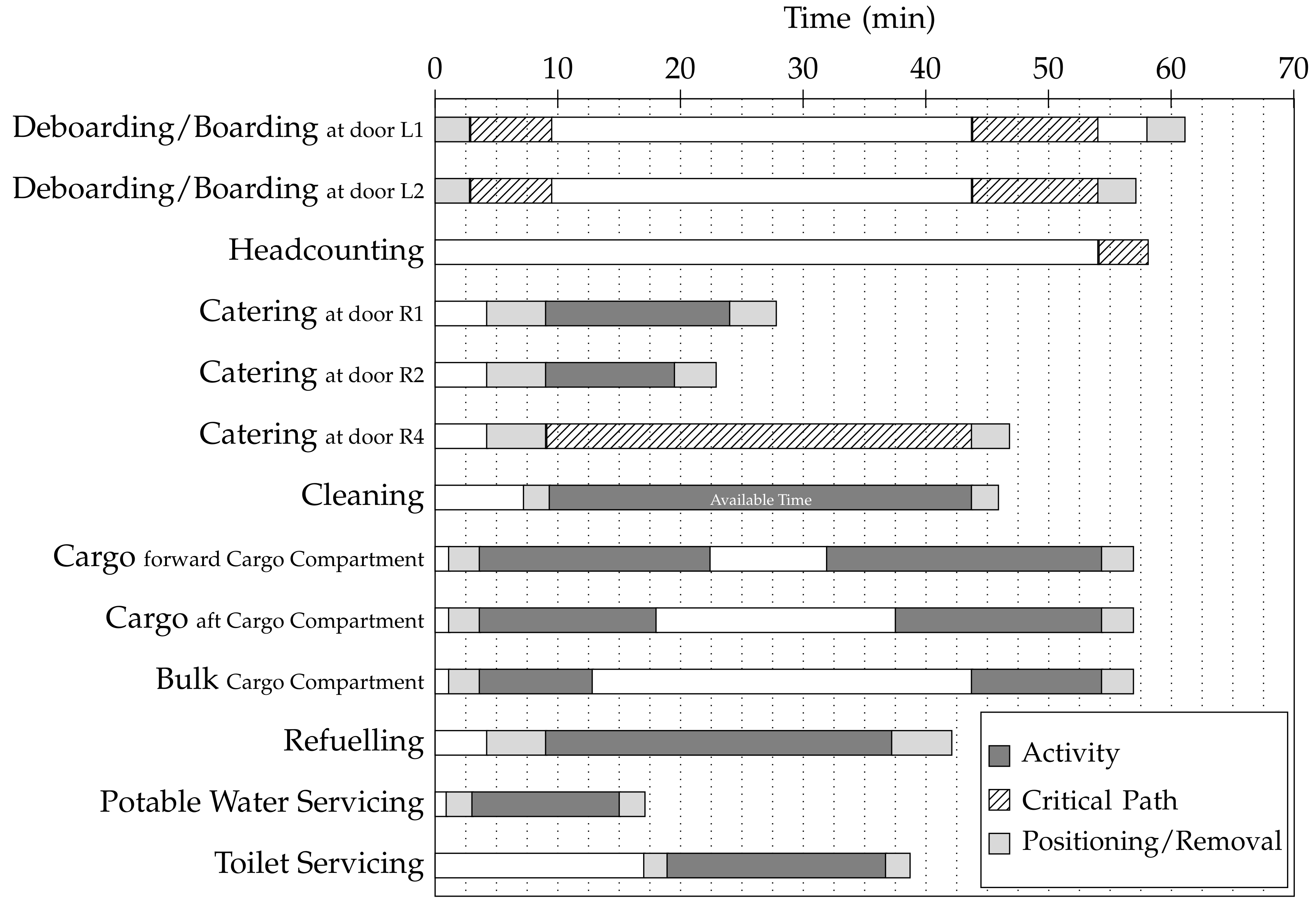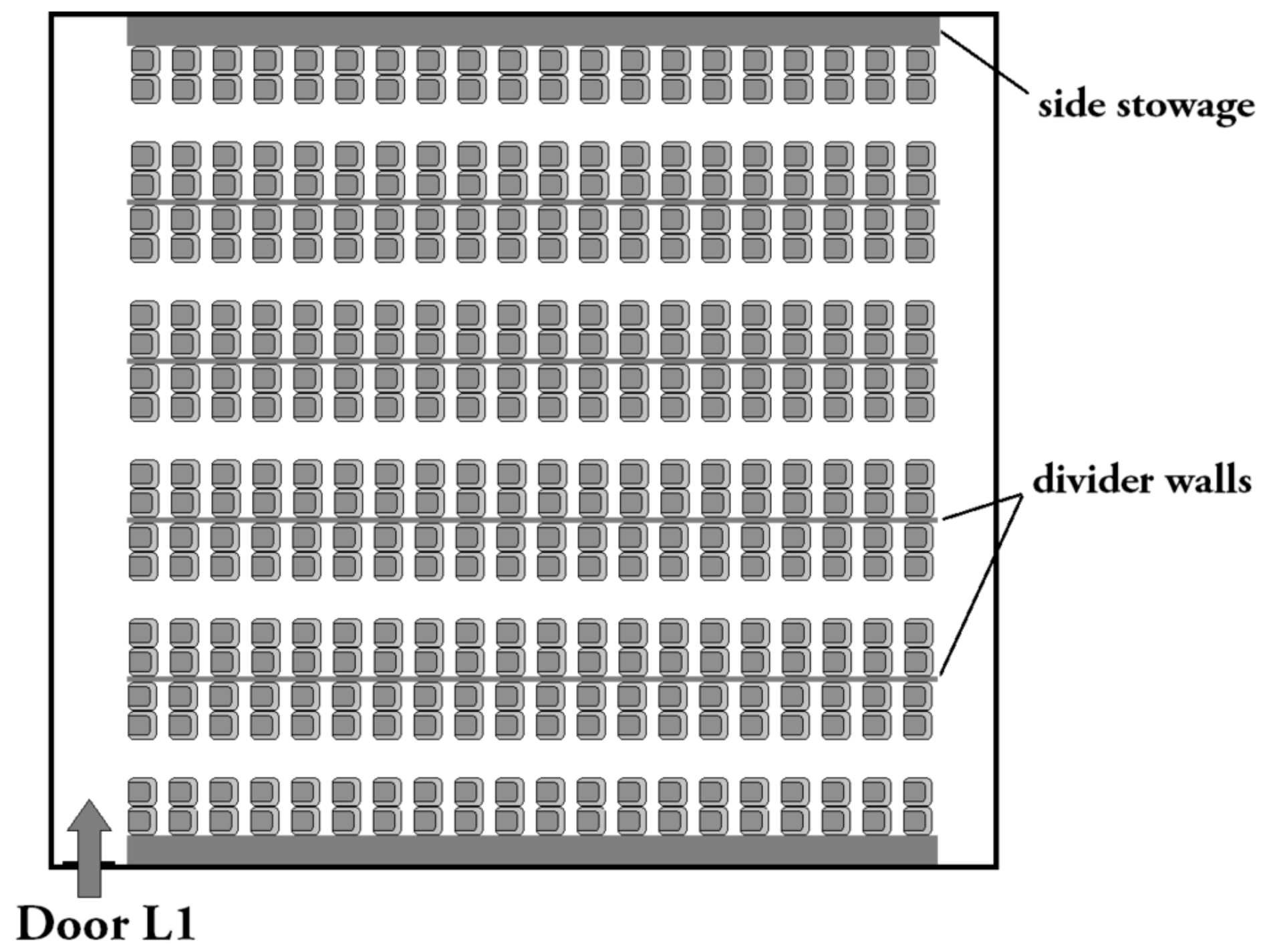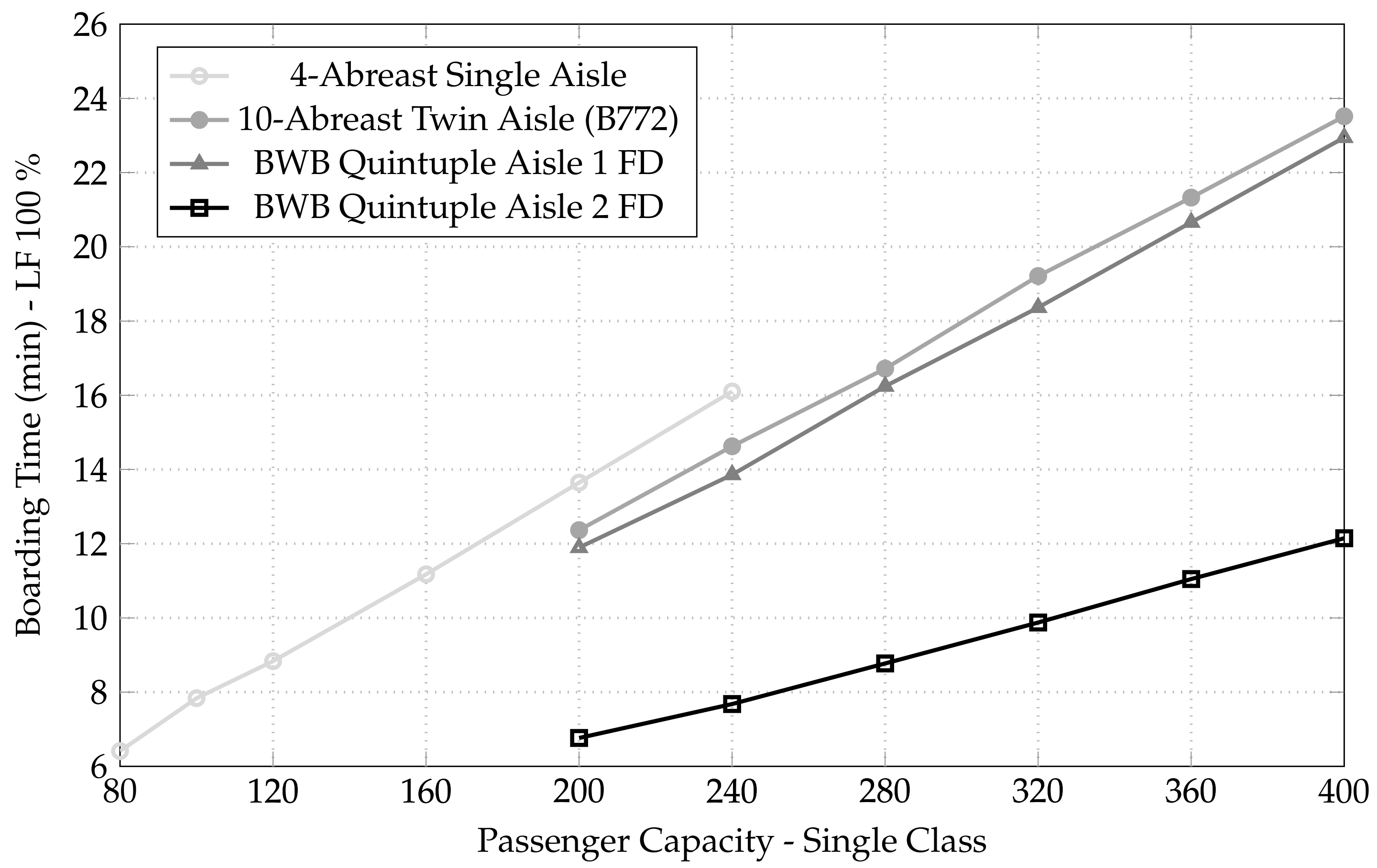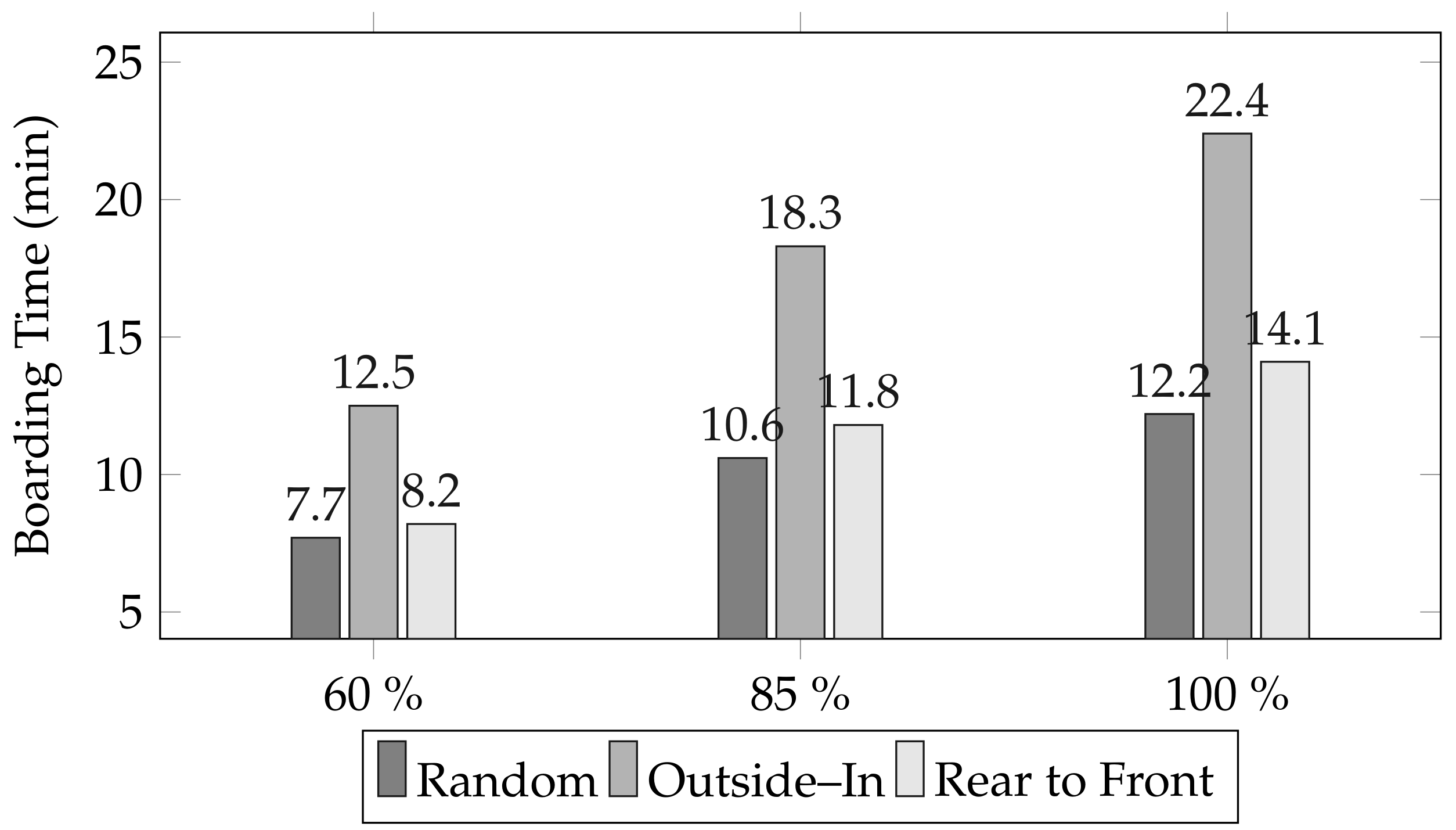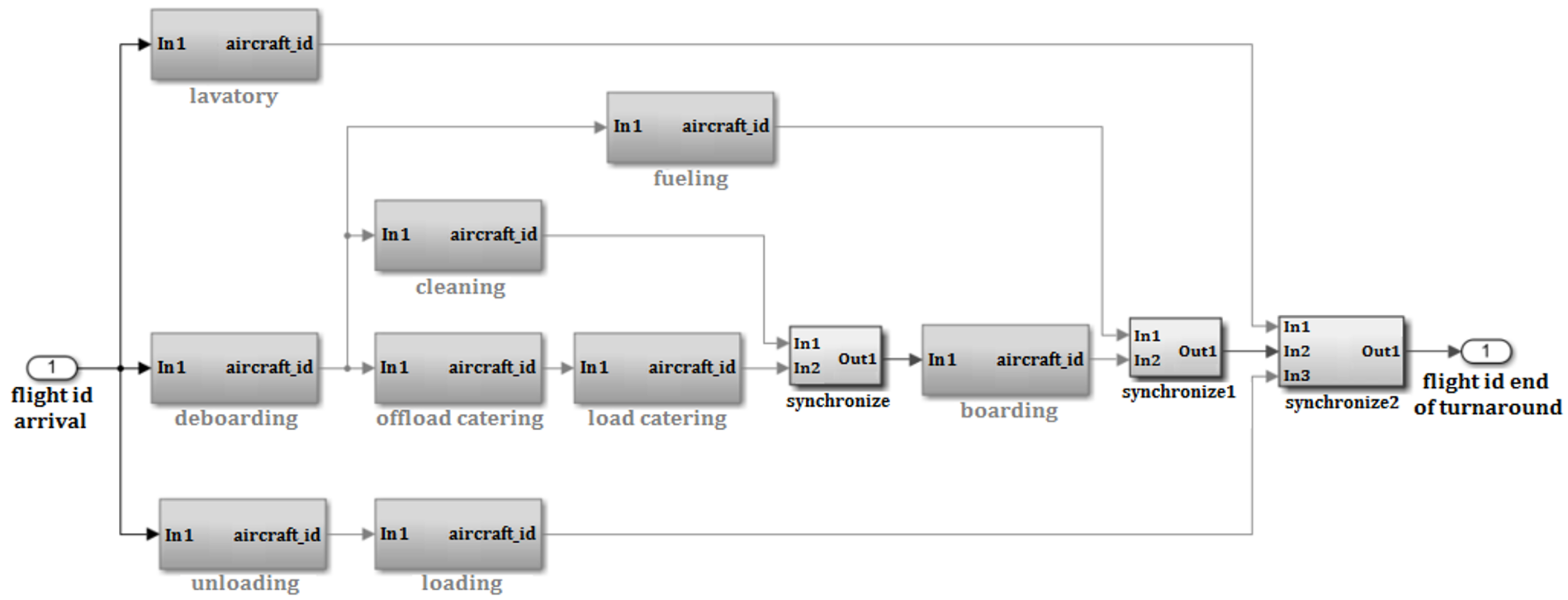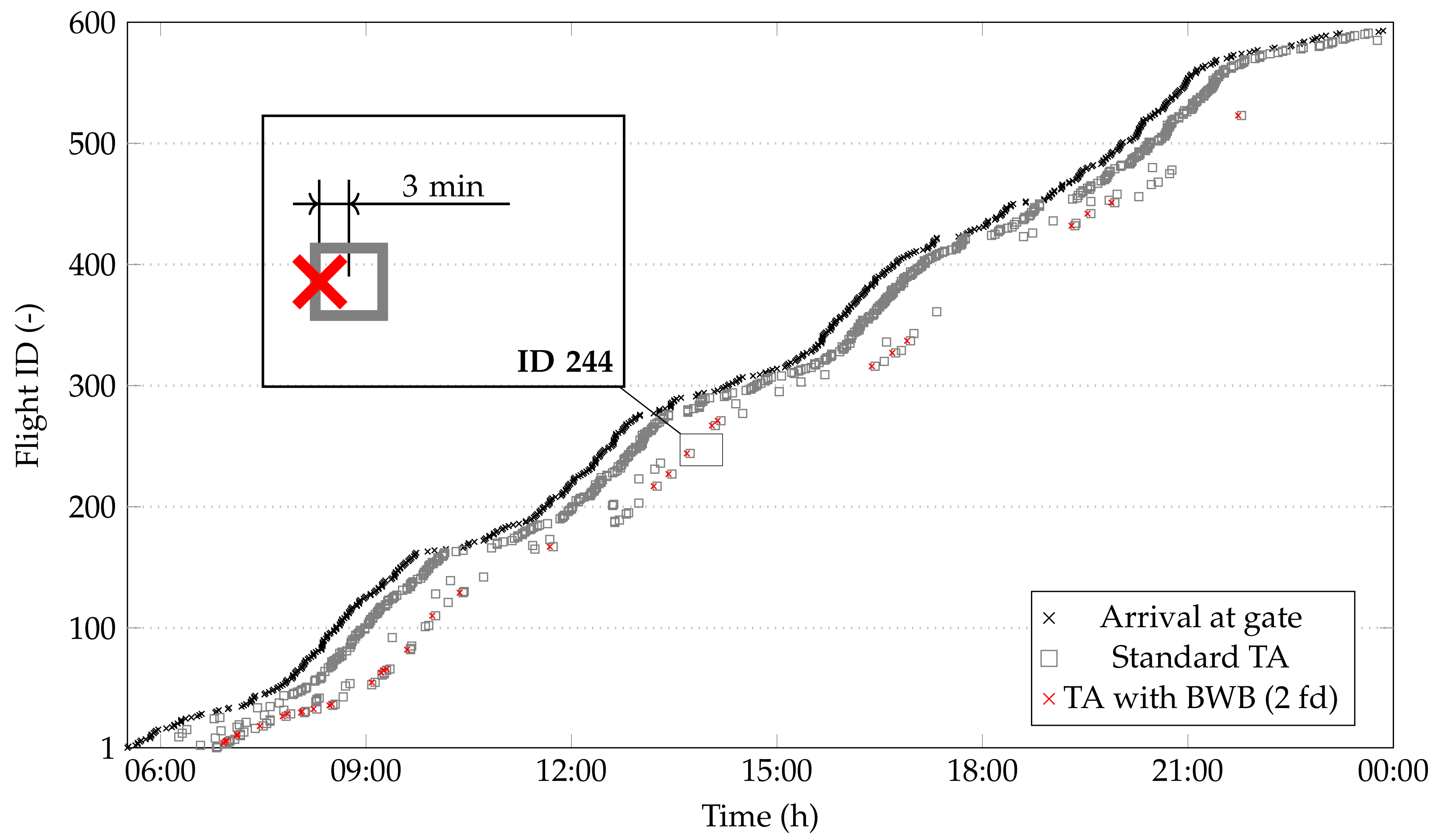1. Introduction
Over the last several decades, not much has changed in the aircraft handling business. In order to achieve the highly ambitious goals of the European Aviation Flightpath 2050, aviation must move towards more sustainable energy sources, and has a significant role to play in reducing noise and emissions [
1]. The expectation of new energy sources and aircraft technologies possesses among other things different environmental demands on airport infrastructure and management. This paper studies the impact of a new aircraft design on the ground handling operations at airports.
The paper is structured as follows: The first section provides a brief insight into the turnaround (TA) process, whereas an overview of the future aircraft concepts in the context of the resarch cluster “Energy System Transformation in Aviation” is given additionally. Thereafter, an operational assessment of changes in turnaround processes is taken. Afterwards, properties of the applied agent-based and event discrete framework are explained in
Section 2 and
Section 3. The paper concludes with a summary of the obtained methods to investigate the aircraft turnaround and gives an outlook on future work.
1.1. Future Aircraft Designs
Future aircraft have to meet the goals of less noise as well as lower fuel consumption and emissions, which requires fundamental changes in aircraft design and technologies. Within the project “Energy System Transformation in Aviation”, three aircraft designs [
2] have been generated (
Figure 1). As shown in
Figure 1, one possible application for long-range traffic is the blended wing body (BWB) airplane. Compared to the conventional baseline, the BWB implicates remarkable performance improvements, including drastic reductions in aerodynamic drag together with laminar flow control on wings and fuselage and structural mass reduction [
3]. The BWB with multiple aisle cabin layout may reduce boarding times and tends to result in minimized minimum connecting times, as the boarding is on the critical path. While long-haul flights will be based on synthetic high-density liquid energy storage, regional and short-range transport demands can be realized with electric or electro-hybrid systems [
4]. Accordingly, the impact of the variation in energy supply and transmission in the aircraft on the ground handling has to be taken into account.
Table 1 summarizes the possible reference applications.
1.2. Aircraft Turnaround
In aviation, aircraft turnaround is defined as the airplane parking time between on–block and off–block timestamps. Basically, turnaround includes cleaning, catering, refuelling, cargo and baggage handling, plus getting passengers onto and off of the airplane. Efficient aircraft turnaround will increase the number of productive flying hours. Therefore, faster turnarounds for lower ground times are correlated with higher profits, and an efficient aircraft turnaround is an important element for airlines to be competitive [
5]. Even a minimum reduction in turnaround time at the gate or a remote position from the terminal can produce remarkable benefits, particularly for short range carriers [
6].
The Gannt chart in
Figure 2 shows some general planning information and turnaround design provided by the manufacturer. Obviously not all processes can take place simultaneously. According to local and International Civil Aviation Organization (ICAO) safety requirements, refuelling with passengers on board is only allowed if a fire service is provided. Moreover, cleaning and catering will not take place while passengers are embarking, disembarking, or remaining on board the aircraft. The white regions in the Gantt chart refer to non–activity.
Usually, airliners or ground handlers have individually adopted procedures and corresponding process times. Furthermore, the critical path is not static and mainly depends on the (minimum) turnaround time and the actual delay [
8].
1.3. Operational Assessment of Changes in Turnaround Processes
The impact of future aircraft designs on operational procedures is highly dependent on the specific configuration of aircraft types. As indicated by the simulation results, introducing the suggested BWB concept will likely decrease the overall turnaround time compared to conventional aircraft of similar size by reducing the boarding time. Since airlines incur a loss of revenue as well as operational costs due to prolonged turnaround times [
9], the BWB concept potentially offers economic benefits with regard to the turnaround process. Furthermore, shorter boarding times allow for a greater amount of flexibility in ground handling and might lead to a beneficial restructuring of the process concerning, for example, staff allocation or customer satisfaction [
10]. However, a sharp decrease in boarding times or additional changes regarding other activities during the turnaround process might limit the effectiveness of further improvements. Therefore, an integrated approach including all activities of the turnaround process must be applied to fully assess the operational changes implied by the BWB concept aircraft.
The same approach is to be utilized for the assessment of operational changes of other future aircraft types as well. Especially with regard to the proposed short-range aircraft in
Figure 1a, different sorts of energy sources must be taken into account. Instead of the standard refuelling process, the resulting turnaround necessarily includes activities to provide H
or electric energy. Thus, the structure of the overall process is likely to differ from the conventional turnaround concerning both the included activities as well as the critical path. In addition, aspects of storing and transporting H
or electric energy must be considered with respect to operational as well as infrastructural planning of the turnaround process.
2. Boarding Simulation
One approach of the microscale model for simulating the operations and interactions of passengers in an attempt to predict the boarding time is the agent-based simulation. The agent-based modeling is a simulation modeling technique that focuses on the individual active components of a system. It is a computational model for simulating the interactions of active entities, known as agents, in terms of assessing their effects on the system as a whole. These autonomous agents may be vehicles, products, companies or in this case passengers [
11].
To investigate the boarding process different passenger flow model approaches have been proposed in literature. Dealing with different boarding strategies, an agent-based simulation model was conducted by Livermore [
12] and Audenaert et al. [
13]. The commercial air traffic simulation CAST offers also the possibility to simulate the passenger ingress process [
14]. The simulation model created by Schultz et al. is based on the so called asymmetric simple exclusion process, where the boarding can be descrided as one dimensional, stochastic forward directed and space and time discrete process [
15]. An overview of existing microscopic passenger flow model approaches is provided in [
16].
The passenger flow simulation framework PAXelerate focuses on the assessment of novel cabin architectures and is used to determine the boarding time [
17]. Using an A-Star search algorithm, the passengers are able to take the shortest and most cost-efficient path to their assigned seat. The agent builder based on a Gaussian distribution allows the creation of passengers with individual properties like body size, age, and walking speed (
Table 2).
Interruptions like luggage stowing or clearing the way for other passengers in order to allow them to reach their seat are modeled as time delays. These input values are provided by the software developers and show a good correlation with the common research approaches [
18,
19]. An integrated cabin layout generator is provided to define cabin characteristics such as overall length and width as well as seat configuration and type of seating classes. A more detailed report about the open source software PAXelerate can be found in [
17].
2.1. Reference Applications
Within the framework of the proposed investigation, the main focus will be put on the boarding simulation of the blended wing body aircraft. The reference application for the BWB features 400 seats in an one-class (high density) twenty-abreast quintuple-aisle layout, as illustrated in
Figure 3 and
Figure 4.
The passengers have randomly assigned seats and enter the cabin via main door L1.
Table 3 summarizes the cabin layout characteristics for the short and long haul reference cases. The values for seat pitch, seat width, and aisle width are based on typical economy class seats [
20,
21]. A more detailed description of the structural design of the BWB fuselage is available in [
22].
The boarding simulation results are obtained with an input set of 100% load factor (LF) and an usual distribution for a low degree of hand luggage on the basis of [
5] (no: 20%, small: 40%, medium: 35%, large: 5%). The literature provides various values regarding passenger boarding rate. According to Airbus, the boarding rate amounts to 15 passengers/min (PPM) per door [
23]. Other estimations range from 18 to 30 PPM [
24]. Under these directives, a boarding rate of 18 PPM per door is assumed for the simulation runs. It should be noted that such LFs are rarely achieved and the impact of hand luggage distribution on boarding times is distinct and proven by [
5]. However, a full load must be assumed to plan the aircraft schedule. To arrive at a stable mean value, a great number of simulations need to be run (Monte Carlo method). The following values for the boarding times were obtained, as shown in
Table 4.
For each configuration (and strategy) the boarding simulation was run fifty times. In case of the BWB the static analysis provided initial evidence for improved robustness.
Figure 5 shows the boarding time as a function of the passenger capacity for the different seat configurations. As expected, the boarding times increase with the number of passengers. Comparing the BWB cabin concept with the contemporary B772 of similar passenger capacity reveals lower boarding times. Furthermore, it can be seen that the use of a second front door (FD) on the same side significantly improves the passenger ingress process. The benefit increases with higher passenger capacity, and an efficiency gain of 42% for the BWB with 200 seats up to 47% (400 seats) can be observed.
As shown in [
25] the boarding of a twin-aisle aircraft also would benefit from the utilization of a second (rear) door, which results in 25–30% faster boarding depending on the boarding strategy. But it must be noted that in this case the cabin is parted into two sections, whereas some passengers are boarded via the front door and others via the rear door. In contrast to the BWB there is marginal space for a second front door on the same side. Significant improvements could also be made using a quarter and three–quarter door, splitting passengers into four streams. This scenario could enable an estimated boarding time reduction by 55% for tube and wing aircraft [
26]. Compared to conventional seat layouts, the probability of passengers in the wrong alley will most likely increase. Therefore, flight attendants have to show the passengers the direct way to their allocated seats to avoid disorientations. However, the simulation model does not account for those situations.
2.2. Boarding Strategies
Interested in speeding up the boarding procedure, airlines have tested different boarding strategies. There are many ways to improve the boarding process and various procedures have been implemented that designate a predefined series of passengers entering the aircraft depending on their assigned seats [
27,
28]. To determine the efficiency, three different boarding options are simulated, as shown in
Figure 6:
Random: The passengers enter the aircraft randomly without a special grouping.
Outside–In: The BWB cabin is parted into five segments, whereas the last segment is boarded first, then moving to the front one by one. For each cabin segment, passengers with window seats get into the aircraft first, then those with aisle seats.
Rear to Front: The traditional strategy commonly used in the industry. This strategy consists of loading the airplane from the back to the front.
The percentage of seats filled (LF) is set to 60%, 85% and 100% (400 PAX). Interestingly, a completely random boarding policy outperforms all others, presumably because it randomly avoids space conflicts. Another surprising finding is that the outside-in strategy crystallizes as the worst performing policy, whereas former studies of conventional aircraft indicated that this procedure is one of the fastest [
15,
29]. This is probably traced back to the fact that each cabin segment is loaded separately beginning with the last one, thus leading to jam formation. It must be pointed out that the implementation of the outside-in procedure on the BWB cabin layout differs from the common definition of the resarch community.
3. Turnaround Simulation
The boarding simulation was integrated into a generic turnaround simulation, which primarily estimates the time required for the cargo loading, catering, cleaning, and refuelling sub-processes. The aim is to develop a framework which provides the means to investigate the influences of new aircraft design and energy or propulsion concepts on the ATM system following a holistic approach. The turnaround simulation itself was implemented into a discrete event simulation environment based on MATLAB/Simulink/SimEvents. SimEvents builds on a flow-based modeling approach where so-called entities flow as commodities through the system (or network) from node to node. This transaction-based modeling concept [
30] depends on events which evoke the advancing of an entity in the network, such as the beginning or the end of a process. Typical modeling blocks, which can also be found in other discrete event simulation environments, comprise generators, sinks, servers, gates or queues, and entities. The latter can be assigned with attributes, which can be manipulated during the course of the entity through the network, thus affecting its proceeding. The environment used in this generic approach furthermore comprises additional functions, tailored to specific needs of the depicted turnaround process, such as synchronization, automatic data evaluation, generic configuration, or Monte Carlo functionalities. New functions can easily be implemented by means of the underlying MATLAB domain.
The developed environment provides hierarchical modeling (thus allowing for modeling different levels of detail) and stochastic functionalities to provide easy adaption to requirements, defined by particular conceptual models and (if available) real-life operational data. Conceptual and data models could be derived from specific airport or airline characteristics.
The simplified generic turnaround model used for this case study is provided in
Figure 7. It depicts a high level of hierarchy of the modeling environment itself. Here, a parallel fueling process was adapted as a possible option. Due to the generic character of the modeling environment, this could be easily adapted to the regulation which forbids parallel fueling by changing the structure of the model by drag and drop. The particular sub-process durations were deducted from the manufacturer, as shown for example in
Figure 2. Aircraft types were grouped into four major classes [
20,
31,
32,
33].
To generically test possible implications on the operational processes on the ground and to evaluate the proposed framework (with respect to the boarding process), one typical day (17 November 2017) in Frankfurt Airport (FRA) was chosen as shown in
Figure 8. Concerning this scenario example, it has to be mentioned that only for a subset of arrivals, departures could be assigned.
Due to requirements of the turnaround simulation, the arrivals were labeled with ascending flight identification numbers, since the entities (i.e., aircraft) in the simulation model have to be unequivocal. Because of missing departure information, as mentioned above, only arrivals were considered for the calculation of the turnaround duration in this study. Thus, a comparison between turnaround durations and scheduled departure times is neglected at this step. Since it was decided to use only arrivals as input for the simulation model, the full set of arrivals at that day in FRA was used as shown in
Figure 9.
Figure 9 illustrates the implications of the altered boarding durations when introducing the BWB aircraft into current operations at FRA. In this scenario, 593 arrivals and 35 different types of aircraft are used as input for the turnaround simulation. Exemplary, all Boeing 777-200 (B772), Boeing 777-300R (B77W), Airbus A340-300 (A343), and Airbus A340-600 (A346) were substituted by the BWB. The boarding time of the BWB equals the two front door configuration with a 100% load factor. Though a substantial savings with regard to the duration of the boarding process could be expected up to 47%, the turnaround process as a whole reveals smaller savings, see
Table 5. This is due to the critical path of the turnaround model, where the unloading and loading sub-processes also define the end of the turnaround.
Hence, it will be necessary to investigate the loading sub-process of the new design configuration of the BWB.
Figure 10 gives an outlook of possible vehicle configuration for the BWB, affecting the loading sub-process and to be taken into account during future investigations of the sub-process.
4. Conclusions and Outlook
This paper investigated the boarding procedure on the basis of a new seat layout which was proposed for a new blended wing body airplane. The study is part of an interdisciplinary research project which evaluates future propulsion, energy and design concepts. Here, the design as well as the seating configuration for the newly shaped aircraft was deducted, providing the input for the boarding simulation. Since a holistic approach, in order to assess the implications of the new concepts on the ATM system, will be implemented at a later stage, the methodology of a suitable framework has to be assessed. This was done in two steps. Firstly by generically creating boarding times, using the open source, agent-based passenger flow simulation software PAXelerate and respective default input parameters. Stochastic influences of the boarding process as well as different boarding strategies were considered. A B772 model served as a reference to compare the calculated boarding times with a conventional aircraft with similar passenger capacity. The analysis of the boarding process identified advantages for the blended wing body cabin layout in comparison with conventional aircraft. With the utilization of a second front door on the same side, significant enhancements are achieved, though this is currently not foreseen in the aircraft design.
In the second step, the calculated estimations of boarding times were introduced into a traffic scenario of Frankfurt in order to evaluate the simulation environment which represents the complete turnaround and will be subsequently used to simulate different airports. Here, a simplified, generic turnaround model was implemented into a discrete event simulation environment, using standard times of sub processes, provided by manufactures. Bearing in mind the dependencies of the turnaround on operational procedures of particular airlines, airports or ground handlers, as well as on regional influences or seasonal patterns, this generic approach was chosen to test the methodology rather than to reproduce operational data of specific conditions. The turnaround simulation of the chosen generic scenario showed that by an exemplary replacement of conventional aircraft of similar passenger capacity, the blended wing body aircraft design has the potential to increase the efficiency of ground handling. In future studies, the focus will lie on the modeling of the disembarking process. Furthermore, a refinement of the boarding simulation will be carried out using other simulation packages and investigating the impact of different passenger boarding rates and hand luggage distributions. Due to the fact that the refueling process is affected by new energy storage concepts, the turnaround simulation model will be adapted to consider these new process durations which address the variation of energy storage and transmission in the aircraft.

